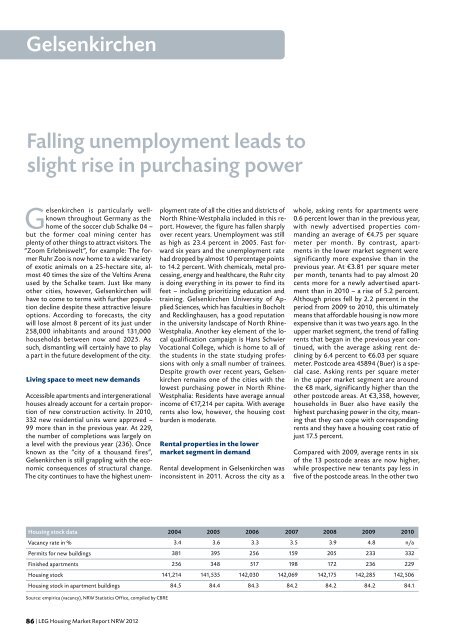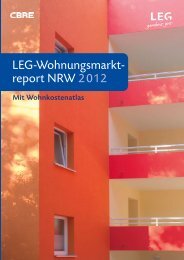LEG Housing Market Report NRW 2012
LEG Housing Market Report NRW 2012
LEG Housing Market Report NRW 2012
You also want an ePaper? Increase the reach of your titles
YUMPU automatically turns print PDFs into web optimized ePapers that Google loves.
Gelsenkirchen<br />
Falling unemployment leads to<br />
slight rise in purchasing power<br />
Gelsenkirchen is particularly wellknown<br />
throughout Germany as the<br />
home of the soccer club Schalke 04 –<br />
but the former coal mining center has<br />
plenty of other things to attract visitors. The<br />
“Zoom Erlebniswelt”, for example: The former<br />
Ruhr Zoo is now home to a wide variety<br />
of exotic animals on a 25-hectare site, almost<br />
40 times the size of the Veltins Arena<br />
used by the Schalke team. Just like many<br />
other cities, however, Gelsenkirchen will<br />
have to come to terms with further population<br />
decline despite these attractive leisure<br />
options. According to forecasts, the city<br />
will lose almost 8 percent of its just under<br />
258,000 inhabitants and around 131,000<br />
households between now and 2025. As<br />
such, dismantling will certainly have to play<br />
a part in the future development of the city.<br />
Living space to meet new demands<br />
Accessible apartments and intergenerational<br />
houses already account for a certain proportion<br />
of new construction activity. In 2010,<br />
332 new residential units were approved –<br />
99 more than in the previous year. At 229,<br />
the number of completions was largely on<br />
a level with the previous year (236). Once<br />
known as the “city of a thousand fires”,<br />
Gelsenkirchen is still grappling with the economic<br />
consequences of structural change.<br />
The city continues to have the highest unem-<br />
<strong>Housing</strong> stock data 2004 2005 2006 2007 2008 2009 2010<br />
Vacancy rate in %<br />
Permits for new buildings<br />
Finished apartments<br />
<strong>Housing</strong> stock<br />
<strong>Housing</strong> stock in apartment buildings<br />
Source: empirica (vacancy), <strong>NRW</strong> Statistics Office, compiled by CBRE<br />
86 | <strong>LEG</strong> <strong>Housing</strong> <strong>Market</strong> <strong>Report</strong> <strong>NRW</strong> <strong>2012</strong><br />
ployment rate of all the cities and districts of<br />
North Rhine-Westphalia included in this report.<br />
However, the figure has fallen sharply<br />
over recent years. Unemployment was still<br />
as high as 23.4 percent in 2005. Fast forward<br />
six years and the unemployment rate<br />
had dropped by almost 10 percentage points<br />
to 14.2 percent. With chemicals, metal processing,<br />
energy and healthcare, the Ruhr city<br />
is doing everything in its power to find its<br />
feet – including prioritizing education and<br />
training. Gelsenkirchen University of Applied<br />
Sciences, which has faculties in Bocholt<br />
and Recklinghausen, has a good reputation<br />
in the university landscape of North Rhine-<br />
Westphalia. Another key element of the local<br />
qualification campaign is Hans Schwier<br />
Vocational College, which is home to all of<br />
the students in the state studying professions<br />
with only a small number of trainees.<br />
Despite growth over recent years, Gelsenkirchen<br />
remains one of the cities with the<br />
lowest purchasing power in North Rhine-<br />
Westphalia: Residents have average annual<br />
income of €17,214 per capita. With average<br />
rents also low, however, the housing cost<br />
burden is moderate.<br />
Rental properties in the lower<br />
market segment in demand<br />
Rental development in Gelsenkirchen was<br />
inconsistent in 2011. Across the city as a<br />
whole, asking rents for apartments were<br />
0.6 percent lower than in the previous year,<br />
with newly advertised properties commanding<br />
an average of €4.75 per square<br />
meter per month. By contrast, apartments<br />
in the lower market segment were<br />
significantly more expensive than in the<br />
previous year. At €3.81 per square meter<br />
per month, tenants had to pay almost 20<br />
cents more for a newly advertised apartment<br />
than in 2010 – a rise of 5.2 percent.<br />
Although prices fell by 2.2 percent in the<br />
period from 2009 to 2010, this ultimately<br />
means that affordable housing is now more<br />
expensive than it was two years ago. In the<br />
upper market segment, the trend of falling<br />
rents that began in the previous year continued,<br />
with the average asking rent declining<br />
by 6.4 percent to €6.03 per square<br />
meter. Postcode area 45894 (Buer) is a special<br />
case. Asking rents per square meter<br />
in the upper market segment are around<br />
the €8 mark, significantly higher than the<br />
other postcode areas. At €3,358, however,<br />
households in Buer also have easily the<br />
highest purchasing power in the city, meaning<br />
that they can cope with corresponding<br />
rents and they have a housing cost ratio of<br />
just 17.5 percent.<br />
Compared with 2009, average rents in six<br />
of the 13 postcode areas are now higher,<br />
while prospective new tenants pay less in<br />
five of the postcode areas. In the other two<br />
3.4 3.6 3.3 3.5 3.9 4.8 n/a<br />
381 395 256 159 205 233 332<br />
256 348 517 198 172 236 229<br />
141,214 141,535 142,030 142,069 142,175 142,285 142,506<br />
84.5 84.4 84.3 84.2 84.2 84.2 84.1




